Dove Hunting in Argentina Beretta Style – Part I: The Mission
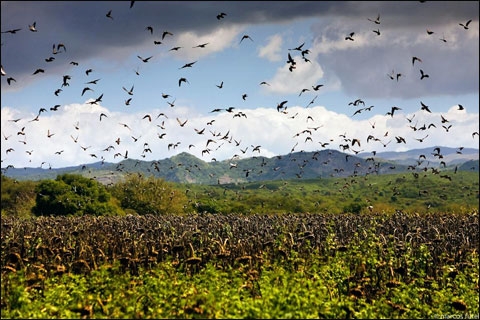
An important point you should understand about high-volume dove hunting in the Cordoba region of Argentina is that it ain’t for crybabies. Set out to shoot 1,000, 2,000 or 3,000 doves per day or more and you will inevitably experience the pain. Cheeks swell, shoulders bruise, palms blister and related bumps and aches arise as a matter of course.
But on the flight home, you remember standing in the brush blind, the doves relentless and mind-blowing, the bird boy stuffing shells faster than you imagined possible, uno, dos, tres you shout, counting the birds that tumble from the sky as you empty the shotgun and you turn to him asking how many and he glances at the counter and says 417 and lunch is still hours away – the exhilaration a new height of brilliance that you ultimately believe has changed your life forever.
And a sudden realization takes hold at 25,000 feet: you must return to Cordoba, really.
Experiencing high-volume doves in Argentina gives you entrée into a brotherhood of hunters who have endured one of the last extreme forms of bird shooting on the planet. The exuberance and triumph you feel can only be shared with others who have been there. And almost to the man, each will reveal they’re itching to get back at the first possible opportunity.
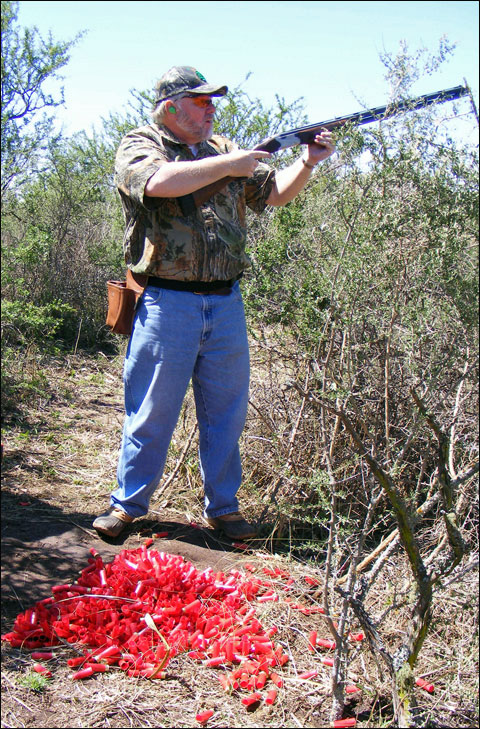 Rick Cundiff in the brush blind at Sierra Brava Lodge.
Rick Cundiff in the brush blind at Sierra Brava Lodge.I had spent about a week in Cordoba, Argentina with my friend, Rick Cundiff, shooting doves at two spectacular destinations. Our first stop was Sierra Brava Lodge, followed by a hunt at Estancia Los Chañares.
Both places are affiliates of the Beretta Trident Program. If you’re not familiar with the Beretta Trident Program, it’s the first and only system to rate shooting sports venues. Not an endorsement for purchase, “Tridents” are awarded for excellence, like Michelin® stars for restaurants. Only five percent of destinations worldwide are considered good enough to merit even one Trident.
While the Beretta Trident Program recognizes the top hunting destinations in Argentina, there is one service universally offered regardless of where you stay: shotgun rentals. And the shotgun of choice at the lodges is a 20-gauge semiautomatic, with 28-gauge over/unders also usually available, and possibly even a .410.
 Put your mind to it and you can shoot 500 doves in Cordoba within several hours. Bird boys carry a counter to tally up your results each day and at the end of the trip.
Put your mind to it and you can shoot 500 doves in Cordoba within several hours. Bird boys carry a counter to tally up your results each day and at the end of the trip. The thinking goes, when it comes to high-volume dove hunting, the subgauge shotguns are softer on the hunter than a 12 gauge – without any perceptible difference in the results. And this tenet is largely true. At Sierra Brava Lodge and Estancia Los Chañares there are documented accounts of hunters bagging 5,000, 6,000 and 7,000 or more doves in a single day using 20-gauge semi-autos.
A record was achieved at Sierra Brava in late January 2010. Since Argentina is in the Southern Hemisphere, January is Summer there – meaning that the days are longer for marathon dove hunting. This enabled one gentleman to down 11,301 doves after 14 hours as winds reached 30 to 40 miles per hour. Over 14,250 shells were expended – or a shotgun shell fired about every four seconds from four 20 gauge Beretta semi-autos in rotation. Approximately 5,000 shotgun exchanges took place between the gentleman and his bird boy. The first shot was fired at 6:32 AM, the last at 8:31 PM.
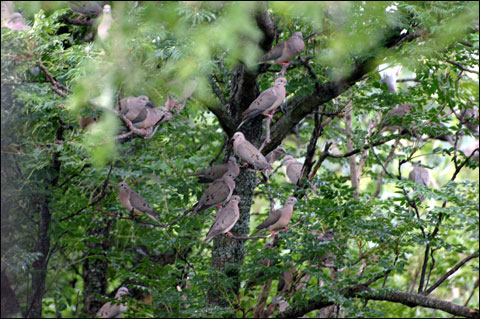 Argentina’s Golden Eared Doves roost in thorn trees that shelter them against natural predators.
Argentina’s Golden Eared Doves roost in thorn trees that shelter them against natural predators.If you relish non-stop action, Argentina is a wingshooter’s paradise. There are no limits due to the mind-boggling number of Golden Eared Doves in the country. In Argentina, the dove population is pegged at around 55 million – with the largest roost in Cordoba. The birds are prolific and non-migratory. They nest several times per year, when they produce an average of two eggs each time. Their primary habitat is a thorny, mesquite-like tree that has successfully thwarted most natural predators.
For a close-up look at the dizzying rate of reproduction visit Estancia Los Chañares. Hunters are transported from the lodge to the fields via trucks with elevated seating reminiscent of a safari. Along the dirt trails, from that lofty vantage point, you can see the tree tops inundated with egg-laden nests.
I have read early reports of farmers poisoning the large dove roosts in Cordoba, before hunting evolved into a significant industry. Although the chemical extermination killed millions of birds, the runoff poisoned other animals, and polluted waterways and fields.
 Riding the platform seats in this truck at Estancia Los Chañares provides an observation vantage point of the incredible number of eggs laid in the nests of the Golden Eared Doves.
Riding the platform seats in this truck at Estancia Los Chañares provides an observation vantage point of the incredible number of eggs laid in the nests of the Golden Eared Doves.Because Argentina is one of the largest agricultural producers in the world, the doves have plenty of food and water amid a temperate climate. I’ve seen numbers varying from 20 percent to 40 percent of crops destroyed every year by the doves that gobble up the corn, wheat, soy, sorghum and sunflower. When you consider that Argentina exported some US$86 billion in unprocessed agriculture during 2011, the destruction wrought by the doves is staggering. And if a law is passed that will let the farmers of Argentina increase their output of genetically modified seeds from the current 35 percent of production to more than 80 percent, the dove population could grow far faster than today.
In planning my trip to Argentina, I set two objectives. The first: shoot as many birds as possible. If that goal sounds prosaic, there are plenty of hunters who visit Cordoba simply to shoot a few hours in the morning and then after lunch – satisfied to bag 200 birds per day.
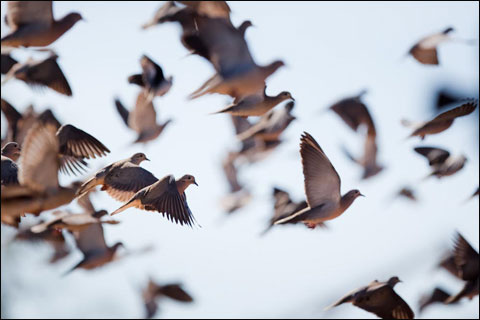 In some of the brush blinds where we shot, the doves clustered in flight for possible multiple hits with a single 12-gauge shotgun equipped with open chokes – a consideration if you’re looking to achieve a personal best.
In some of the brush blinds where we shot, the doves clustered in flight for possible multiple hits with a single 12-gauge shotgun equipped with open chokes – a consideration if you’re looking to achieve a personal best.My other objective included testing common wisdom by evaluating the physical repercussions of a 12-gauge shotgun for high-volume dove hunting. If you’re going for a personal best, an open-choked 12 gauge will spread more pellets to hit multiple doves with a single shot than a 20 gauge. Add it up and the ⅛ ounce uptick credited to the 12-gauge loads over the 20 gauge can be noteworthy over a full day of shooting.
Toward that end, I selected two Berettas equipped with the company’s integrated Kick-Off recoil-reduction system. Kick-Off incorporates a pair of hydraulic dampeners, coupled with springs, in the stock of the shotgun. Upon firing, the system compress – moving the stock along your cheek. Complemented by a new Micro-Core recoil-pad polymer, Beretta claims a total recoil loss of 70 percent compared with “the nearest competition.”
 Beretta’s X400 Light with the Kick-Off recoil-reduction system in the stock.
Beretta’s X400 Light with the Kick-Off recoil-reduction system in the stock.The high-volume experiment would embrace both a semi-auto and an over/under in 12 gauge. I opted for Beretta’s A400 Xplor Unico Light gas-operated semi-auto. I had already shot that gun in South Dakota on pheasants and thought it was brilliant. For an over/under, I took Beretta’s SV10 Prevail clays gun. Both models represented the state-of-the-art in their respective configurations and price point.
The A400 Light is the wingshooting version of the original clays model. The 12-gauge A400 Light weighs about 6.8 pounds with a 28-inch barrel and Kick-Off – or approximately a half-pound less than an equivalent Beretta A400 Xcel Sporting with 29-inch barrels. The weight reduction is primarily attributed to a shorter receiver made of aluminum in both versions. The tradeoff impacts shell sizes and capacity.
As with the original A400 introduced in 2009, the A400 Light employs Beretta’s Blink operating system. The Blink operating system can cycle shells ranging from 2¾ to 3½ inches using a rotating bolt head that enables four shells to be shot in under a second (with the plug removed). From the factory, the A400 Light handles two shells in the magazine plus one in the chamber. Loads can be as small as 7/8 ounce without jamming. Beretta also claims that the rotating bolt head demands less maintenance than its predecessor, which established the Beretta 390 and 391 as among the most reliable gas semi-autos ever.
Beretta tapped its European DT 11 competition shotguns for the Steelium barrels on the A400. As Beretta explains it, Steelium is a manufacturing process that uses a tri-alloy steel billet, which is deep drilled, cold-hammer forged and undergoes a special vacuum distension. The payoff, according to Beretta, is a lower profile barrel with improved forcing-cone tapering, reduced muzzle flip and better handling for faster target acquisition.
The A400 Light that accompanied me to Argentina featured a weather-proof synthetic grain finish called Xtra-Wood on the wood stock and forend. The overall package with the aluminum receiver drew praises from fellow shooters at Sierra Brava. Personally, the Xtra-Wood would not have prevented me from buying the gun at the suggested price of $1,500.
 Muller chokes.
Muller chokes.The A400 Light was fitted with a Muller Featherlight choke. Relatively new to the market, Muller chokes have been distinguished by their light weight and controlled patterns. The gloss-black, extended chokes are manufactured from aerospace-grade aluminum infused with ceramic Teflon. Bottom line is that they are half the weight of titanium, one-third the weight of steel and don’t accumulate crud. Muller says that their chokes never loosen – an assertion I found to hold up under the intense shooting conditions of Argentina.
Muller applies different designations than the rest of the industry to their choke constrictions. U1 is .005 inch, U2 is .012 inch, U3 is .022 inch and U4 is 035 inch. The U1 is the rough equivalent of skeet while U4 is described by the company as having an improved modified and extra full choke in the same barrel. I selected a U2, which is Muller’s rendition of an improved cylinder combined with a light modified. The Muller chokes are distinguished by an ultra-modern industrial aesthetic, and are priced at $74.95 each.
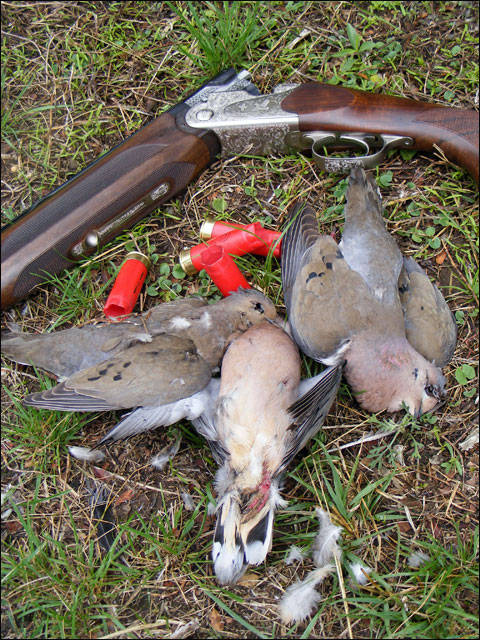 The Beretta SV10 Prevail with game-scene engraving in Argentina.
The Beretta SV10 Prevail with game-scene engraving in Argentina.When it came to the over/under, the Beretta SV10 Prevail clays gun seemed to fit me slightly better than the SV10 Perennia upland model. So in anticipation of hot-barrel shooting, I chose the SV10 Prevail with 30-inch barrels – the shotgun weighing 7¾ pounds.
Introduced in 2009, the SV10 Prevail represented the next generation to Beretta’s 600 series. The SV10 Prevail, however, has a lower profile than the beloved 682 thanks primarily to redesigned hinge pins and forend iron.
As a fresh design, the SV10 Prevail includes a lightweight titanium trigger, vented barrels, shell-removal technology that lets you easily choose between automatic ejection or manual extraction, dual conical longitudinal locking lugs that are self-adjusting for wear, replaceable hinge pins and forend iron that constantly adjusts itself for a tight fit. The shotgun incorporated Beretta’s new Q-Stock for removal of the stock via a single screw that’s accessible through a polished, spring-loaded trap door in the pistol grip – the objective to provide easy trigger removal with the same tool. Of the full set of Optima choke, I decided initially on improved cylinder and light modified for Argentina.
 The standard level of engraving on the Beretta SV10 Prevail.
The standard level of engraving on the Beretta SV10 Prevail.The suggested price for an SV10 Prevail with Kick-Off was $3,098 with standard engraving, and if your tastes lean toward contemporary designs that particular model shows quite well. There’s an elliptical swoosh to the polished sideplates, which are laser engraved with a partial, high-tech checkboard pattern repeated on the locking shoulders. An elongated lever contributed to a svelte appearance of the semi-beavertail forend.
The SV10 Prevail I took to Argentina boasted a higher grade game scene engraving. Bundled with the Kick-Off system, that gun carried a suggested retail price of $3,498.
Putting myself in the shoes of an everyday shotgun enthusiast, I felt satisfied with the best possible pair of shotguns to test my theory of whether or not the 12-gauge would be overkill in Cordoba – on the shooter.
The night before departure, I packed both guns in an FAA-approved travel case. Snapping shut the padlocks, it was time to bring on Argentina.
To Read Part II, please click on this link:
http://www.shotgunlife.com/travel/places-to-shoot/dove-hunting-in-argentina-beretta-style-part-iii-estancia-los-chanares.html
To read Part III, please click on this link:
http://www.shotgunlife.com/travel/places-to-shoot/dove-hunting-in-argentina-beretta-style-part-iii-estancia-los-chanares.html
Irwin Greenstein is the Publisher of Shotgun Life. You can contact him at letters@shotgunlife.com.
Useful resources:
The Beretta Trident Program web site
The Sierra Brava Lodge web site
The Estancia Los Chañares web site
The Beretta SV10 Prevail web site
The Beretta USA web site
The Muller Chokes web site

Irwin Greenstein is Publisher of Shotgun Life. Please send your comments to letters@shotgunlife.com.


Comments